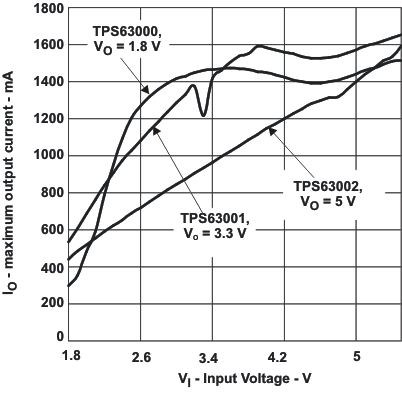SLVS520C March 2006 – October 2015 TPS63000 , TPS63001 , TPS63002
PRODUCTION DATA.
- 1 Features
- 2 Applications
- 3 Description
- 4 Revision History
- 5 Pin Configuration and Functions
- 6 Specifications
- 7 Detailed Description
- 8 Application and Implementation
- 9 Power Supply Recommendations
- 10Layout
- 11Device and Documentation Support
- 12Mechanical, Packaging, and Orderable Information
Package Options
Mechanical Data (Package|Pins)
- DRC|10
Thermal pad, mechanical data (Package|Pins)
- DRC|10
Orderable Information
6 Specifications
6.1 Absolute Maximum Ratings
over operating free-air temperature range (unless otherwise noted)(1)| MIN | MAX | UNIT | |
|---|---|---|---|
| Input voltage on VIN, VINA, L1, L2, VOUT, PS/SYNC, EN, FB | –0.3 | 7 | V |
| Operating virtual junction temperature, TJ | –40 | 150 | °C |
| Storage temperature, Tstg | –65 | 150 | °C |
(1) Stresses beyond those listed under absolute maximum ratings may cause permanent damage to the device. These are stress ratings only, and functional operation of the device at these or any other conditions beyond those indicated under recommended operating conditions is not implied. Exposure to absolute-maximum-rated conditions for extended periods my affect device reliability.
6.2 ESD Ratings
| VALUE | UNIT | |||
|---|---|---|---|---|
| V(ESD) | Electrostatic discharge | Human body model (HBM), per ANSI/ESDA/JEDEC JS-001, all pins(1) | 2000 | V |
| Charged device model (CDM), per JEDEC specification JESD22-C101, all pins(2) | 1000 | |||
(1) JEDEC document JEP155 states that 500-V HBM allows safe manufacturing with a standard ESD control process.
(2) JEDEC document JEP157 states that 250-V CDM allows safe manufacturing with a standard ESD control process.
6.3 Recommended Operating Conditions
| MIN | MAX | UNIT | ||
|---|---|---|---|---|
| Supply voltage at VIN, VINA | 1.8 | 5.5 | V | |
| Operating free air temperature, TA | –40 | 85 | °C | |
| Operating virtual junction temperature, TJ | –40 | 125 | °C | |
6.4 Thermal Information
| THERMAL METRIC(1) | TPS6300x | UNIT | |
|---|---|---|---|
| DRC (VSON) | |||
| 10 PINS | |||
| RθJA | Junction-to-ambient thermal resistance | 46.8 | °C/W |
| RθJC(top) | Junction-to-case (top) thermal resistance | 62.5 | °C/W |
| RθJB | Junction-to-board thermal resistance | 21.4 | °C/W |
| ψJT | Junction-to-top characterization parameter | 1.4 | °C/W |
| ψJB | Junction-to-board characterization parameter | 21.5 | °C/W |
| RθJC(bot) | Junction-to-case (bottom) thermal resistance | 4.1 | °C/W |
(1) For more information about traditional and new thermal metrics, see the Semiconductor and IC Package Thermal Metrics application report, SPRA953.
6.5 Electrical Characteristics
over recommended free-air temperature range and over recommended input voltage range (typical at an ambient temperature range of 25°C) (unless otherwise noted)| PARAMETER | TEST CONDITIONS | MIN | TYP | MAX | UNIT | ||
|---|---|---|---|---|---|---|---|
| DC-DC STAGE | |||||||
| VIN | Input voltage range | 1.8 | 5.5 | V | |||
| VIN | Input voltage range for start-up | 1.9 | 5.5 | V | |||
| VOUT | TPS63000 output voltage range | 1.2 | 5.5 | V | |||
| VFB | TPS63000 feedback voltage | PS/SYNC = VIN | 495 | 500 | 505 | mV | |
| f | Oscillator frequency | 1250 | 1500 | kHz | |||
| Frequency range for synchronization | 1250 | 1800 | kHz | ||||
| ISW | Switch current limit | VIN = VINA = 3.6 V, TA = 25°C | 1600 | 1800 | 2000 | mA | |
| High-side switch ON-resistance | VIN = VINA = 3.6 V | 100 | mΩ | ||||
| Low-side switch ON-resistance | VIN = VINA = 3.6 V | 100 | mΩ | ||||
| Line regulation | 0.5% | ||||||
| Load regulation | 0.5% | ||||||
| Iq | Quiescent current | VIN | IOUT = 0 mA, VEN = VIN = VINA = 3.6 V, VOUT = 3.3 V |
1 | 1.5 | μA | |
| VINA | 40 | 50 | μA | ||||
| VOUT (adjustable output voltage) | 4 | 6 | μA | ||||
| FB input impedance (fixed output voltage) | 1 | MΩ | |||||
| IS | Shutdown current | VEN = 0 V, VIN = VINA = 3.6 V | 0.1 | 1 | μA | ||
| CONTROL STAGE | |||||||
| VUVLO | Undervoltage lockout threshold | VINA voltage decreasing | 1.5 | 1.7 | 1.8 | V | |
| VIL | EN, PS/SYNC input low voltage | 0.4 | V | ||||
| VIH | EN, PS/SYNC input high voltage | 1.2 | V | ||||
| EN, PS/SYNC input current | Clamped on GND or VINA | 0.01 | 0.1 | μA | |||
| Overtemperature protection | 140 | °C | |||||
| Overtemperature hysteresis | 20 | °C | |||||
6.6 Typical Characteristics
